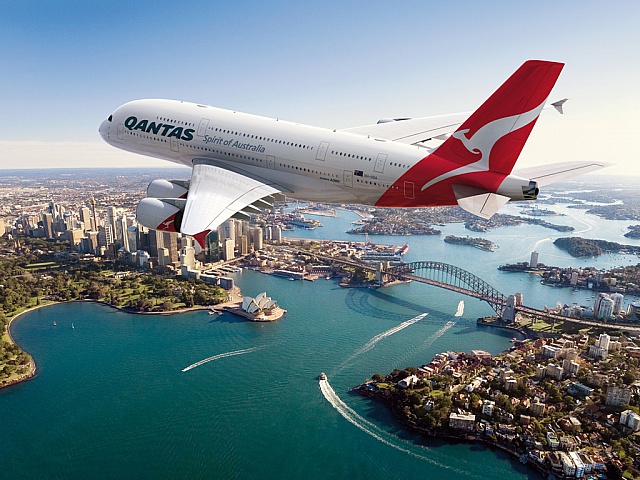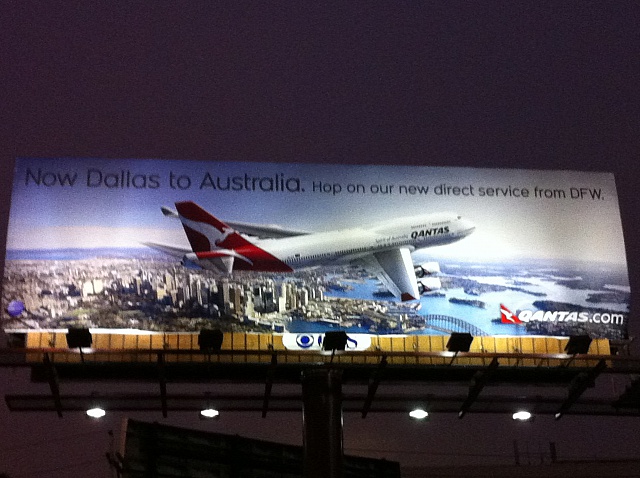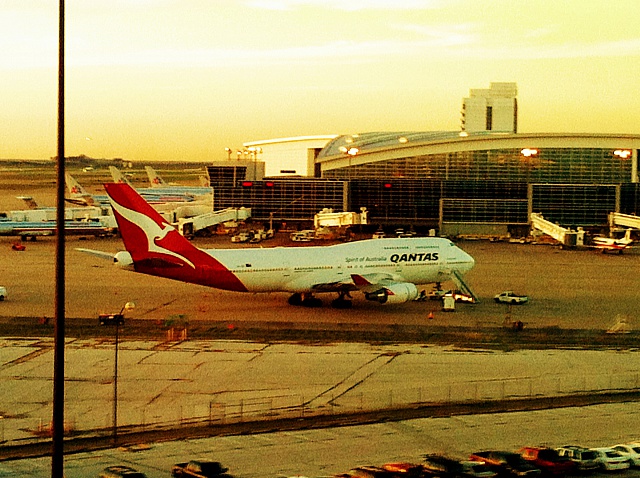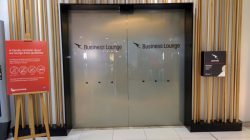
Last week, my Dad texted me a trivia question randomly on a Saturday afternoon:
“Do you know what ‘QANTAS’ stands for?”
Realizing this was likely his tongue-in-cheek manner of testing my airline knowledge, I told him I did not, and he sent me back:
“Queensland and northern territories airways system 🙂 Looks like I can still teach you a thing or two!”
Of course, the smiley and the subsequent message was Dad’s way of saying, “I can outsmart you, son!” Kudos, Dad. Sure, I hadn’t given much thought to the significance of the ‘Qantas‘ acronym; in fact, I hadn’t even realized it was an acronym for the flag carrier of Australia, nicknamed ‘the Flying Kangaroo.’
Oh, and for the record, Dad, you were still off: a quick internet search shows it is actually Queensland and Northern Territory Aerial Services. Still, I’ll give him the title of contest winner since he knew more off his head than I did.
Based in Sydney, Qantas is the largest Australian carrier, and one of the oldest continuously operated airlines in the world. Although I personally have never flown Qantas, nor have been to Australia, most aviation fans, if not general travel enthusiasts, recognize its iconic image as THE Australian airline. The Red Kangaroo tail can be seen in far-flung airports such as Tokyo, London, Honolulu, Los Angeles, New York, Buenos Aires, Frankfurt and all over Oceania, bearing the slogan, “The Spirit of Australia.”
The tragedy at stake
It was once a very profitable airline, known for delivering quality service on its transoceanic flights that connected the rest of the world to the world down under. Its history is rich: starting from an age when it flew the luxurious 707s from the US mainland to Hawaii to Australia, to present times as it was one of the earliest launch customers of the mammoth Airbus A380 aircraft in 2008.
Now, dreams are dashed as the carrier struggles to re-vamp its business model amid years of successive losses, waning customer loyalty, labor woes and overall, lack of forward-thinking vision on behalf of its leaders.
Not unlike other legacy carriers, who have struggled to make ends meet in tougher times, Qantas has seen its problems emanate from a variety of factors, most notably watching its cost structure rise alongside as competition from low-cost and Middle Eastern carriers continually eat into the health of both its domestic and long-haul operations.
In particular, the growth of Middle Eastern airlines such as Emirates and Etihad Airways have dealt blows to Qantas’ once prized “Kangaroo routes” that operated lucrative long-haul services between Australia and Europe (most notably London). The Kangaroo routes thrived on “scissor hub” operations, connecting Europe and Australia originating and terminating traffic over strategic mid-market bases at Bangkok, Singapore and Hong Kong. However, the Middle Eastern carriers, armed with lower cost structures, have flooded the Australia markets with high-density aircraft, offering many seats on a weekly basis that are priced competitively and offer superior service to some of the older, legacy carriers. As such, they have sliced away a large chunk of Qantas’ prized traffic on these routes.
Last August, the company announced a major shake-up in operating strategy, as part of an effort to reduce costs. Core to that plan involved outsourcing jobs and expanding in Asia, with an ambitious plan to launch an all-premium airline, based in Kuala Lumpur, in conjunction with Malaysian Airlines. Naturally, internal reactions on behalf of Qantas’ existing workforce were not in favor of this scheme. In October, unions went up in arms and strikes caused the airline to halt operations, stranding over 70,000 passengers worldwide.
The situation isn’t rocket science. BBC News provided a commentary on the strike situation last October, citing that the legacy carrier has a legacy cost base, and consequently, has to learn how to contend with those costs in order to compete. Of course, managements’ plan to outsource jobs wasn’t necessarily what the unions had in mind, and the effects of the strike caused a devastating blow to Qantas from an operational, financial, and public relations perspective.
BBC News: “Qantas row sign of struggle to compete”
‘Adapt or die’
After settling with its unions post labor-dispute, Qantas continued to move forward with its restructuring plan. Last month, the airline said that it would shed 500 jobs, cut capital spending by A$700 million over two years, review and simplify its maintenance operations, cancel unprofitable routes and retire older aircraft earlier than planned as part of movements to remain on path toward profitability.
Amid changes that have either been announced or implemented within its international network includes leveraging its partnerships by flying into OneWorld alliance hubs, rather than just spoke cities. The carrier moved its nonstop flight from San Francisco to Dallas/Ft. Worth International Airport last May, and will be switching its three-weekly nonstop service from Buenos Aires, Argentina, to Santiago, Chile, later this month. Both Dallas/Ft. Worth and Santiago are hub airports for OneWorld alliance members American Airlines and LAN Airlines, respectively, and Qantas will be able to benefit from larger pools of feed traffic, through interlining and code-sharing, from flying directly into these hubs with robust alliance networks.
Qantas also chopped more than half of their 1-stop flights to London, discontinuing the direct flights to Heathrow from Hong Kong and Bangkok, and pulled out of India completely.
The turnaround strategy involving growth in Asia centered around initial discussions with Malaysian Airlines, budget carrier Air Asia, and Singapore Airlines to set up an all-premium airline in either Kuala Lumpur or Singapore. Given the loss-making nature of Qantas’ international network, the carrier’s chief Executive Alan Joyce emphasized the criticality of tapping into Asia’s low cost environment, as this concentrated effort was part of a five-year revival plan to steer the carrier towards the black.
The purpose of the plan was to reinvest the profits derived from the new premium offering in the carrier’s loss-making long haul operations, thereby hopefully turning a profit on its international operations within three years and making them meet their cost of capital within five.
In February, Joyce had told Australian lawmakers Qantas needed to “adapt or die,” according to a Reuters article published yesterday.
Asian strategy ‘in tatters’
However, the ambitious hopes for Asia appeared to be short-lived. Yesterday, media sources reported that shares in Qantas tumbled 4% after the carrier announced that it had broken off discussions with Malaysia Airlines, which seemed to be the leading carrier of aforementioned three that had denoted the highest level of interest in the Asian strategy. According to Reuters, Qantas issued a brief statement saying that it was ”unable to reach mutually agreeable commercial terms” with Malaysia, as well as the other target partners, involved in the discussions.
It’s a huge letdown for Qantas, having overstocked in this hopeful plan to get the carrier back on course. This setback leaves the airline searching for another partner in Asia to help it retrench along a similar path to recovery, or, even more discouragingly, having to start over from scratch in terms of devising a transformation plan.
Regardless, the sting from these failed discussions does not come with much surprise, given the hugely complex hurdles associated with launching an all-premium product, especially with an airline such as Malaysia, which independently has its a slew of financial crises to attend to on its own.
In my research for today’s posting, I stumbled across an excellent article published in the Sydney Morning Herald, titled, “Asia too risky for Qantas.” The author, Tony Webber, also a former Qantas Group chief economist, makes some excellent points with regards to the fiercely competitive nature of the Asian aviation market and the soft demand for premium carriers. Perhaps the biggest key nugget of information that Webber draws attention to is the real growth centric in Asia, which is within the low-cost carrier market (not surprisingly, as this is pretty much now a global trend).
The growing middle class in Asia, Webber argues, will opt for the low-cost carrier end of the market before trading up to full service. At present, full-service carriers in Asia are struggling with deriving strong premium cabin yields, and they are likely to remain weak since such a target segment closely follows equity markets. Patterns show that because equity markets drive business expectations about future profitability, and therefore discretionary corporate expenditure, the front-end of the plane is less likely to be filled up (where the more lucrative seats are up for sale). Moreover, Asian equities are down 4 percent over this time 12 months ago, indicating that the premium business demand is likely to remain weak for the time being.
Conclusively, Webber’s analysis seems to indicate that Qantas was likely to fall very short of their expectations in this new strategy anyways. Some industry experts are even going as far to say that this whole setback was actually a “blessing in disguise” and Qantas is walking away from being on the “brink of a future disaster” given that, theoretically, the market they intended to capture is either extremely scarce or practically nonexistent. At least, so sparse that the entire business plan was doomed from the start.

Cost control: not just about outsourcing
A few weeks ago, I wrote a blog entry featuring bankrupt American Airlines and lessons in cost structure, and how maintaining control over shifts in cost controls can thwart an airline from having to torpedo their own brand in order to stay profitable and competitive.
To me, it seems like the uncertain future of Qantas is somewhat at stake for neglecting to address the same issue. However, unlike American, the real imminent danger for Qantas is that it seems intent on stripping itself of its own national identity, as evidenced by its outsourcing plans. Shifting jobs overseas would allow Qantas to hire pilots, crew and maintenance staff at much lower costs than in Australia, while also offering a larger choice of connecting flights, as certain points within Asia are obviously more geographically ideal to displace traffic to a wider array of destinations rather than backtrack all the way to Australia.
However, Qantas’ brand strengths rest on its unique Australian entity and its safety reputation built on Aussie standards. Downplaying the significance of those attributes in an effort to hastily latch onto riding out the lower-wage standards of living in other nations, to most people, sounds like a pretty unsound strategy. In a statement published in Reuters, Richard Woodward, VP of the Australian and International Pilots Association, wrote:
“It (Qantas) needs a management which is prepared to build on its strengths instead of consuming energy pursuing half-baked, adventurist plans in Asia.”
The truth that keeps being overlooked is that Qantas DOES have a low-cost brand in is Jetstar operations (JetStar Asia, JetStar Japan and JetStar Pacific) that CAN compete successfully in the Asian market. Above all, why would Qantas seek to invest into a premium brand when this would likely go AGAINST their very own, existing, successful operation that is already well-established in the same geographic sphere? I’m thinking the C-word here, folks, that spells, ‘C-A-N-N-I-B-A-L-I-Z-A-T-I-O-N,” i.e., one of the BIGGEST strategic follies that can be committed in the airline industry.
If they need to fix their loss-making long-haul operations then they need to focus on that aspect and that aspect alone: not on other areas where they are likely to cannibalize what they are doing well (Jetstar) or likely to fail (premium airline) given obvious data points (fuel, economy, competition).
Moreover, the entire business plan, ranging from overall network strategy to core product offering, seemed entirely ambiguous. Crikey.com, an Australian electronic magazine, reported today in their Plane Talker section that the statements in support of the scheme were “ludicrous.” In media interviews conducted with CEO Joyce, the plans for the new premium airline included single aisle aircraft would feature sleeper seats “for sale” that were bigger than those offered on-board their mega-A380 aircraft, for flights of stage lengths often less than six hours.
Imagine, who would want to shell out thousands for a lie-flat bed on a four hour flight?
Furthermore, the details surrounding the plans seemed largely inconsistent, if not confusing. Joyce vacillated between saying that the new brand would be featured on single-aisle A320 aircraft and long-haul A330 equipment. He also said, after Qantas reported a less-than-stellar earnings statement in 2011, that Qantas intended to spend as little as possible on the new aircraft.
It just didn’t add up.

Go global, act local
To top it all of, Crikey reporter Ben Sandilands claims that the methodology behind the business plan went largely against standards for doing business in Asia. As a general rule of thumb, you are expected to keep quiet about big announcements until there is something substantial to talk about. Given the nature of the proposed agreement, which essentially involved an Australian company establishing an ambitious operation on a foreign countries’ home turf, it did not bode well for Qantas to announce its intentions so candidly in Australian media outlets.
“It has been a sorry spectacle, creating a text book case of how not to do business in Asia, and one that is truly astonishing given the access Qantas has enjoyed for decades to wise and experienced counsel in relation to business and governmental relations with the Asia economies.”
Ben Sandilands, author: ‘Red Q is Dead Q but we’ve know that for a while.’
The good news is, this idea did not even get off the ground (no pun intended) so likely, without a sizable money pit to point to as a consequence of this failed plan, future Business School or MBA textbook writers will probably forgo including this example without needing to create an entire case study out of it. But, the larger issue at hand is what is the alternative strategy for Qantas?
What’s next for the Red Kangaroo
The easy answer is, the carrier’s habitual pattern of blaming its employees, competitors, geographic location, and slipping number of loyal fliers, will not help it survive in the long run.
The challenging answer is, they are pretty much back to the drawing board. If their management still feels that the solution lies in creating a premium Asian brand, the truth is that Qantas may find itself on its own for that venture. Not only that, they will have to be prepared to shell out more capital than they’d like if that were to be the case, which goes against their hopes for having a “capital-light” option. Again, their bold visions seem to largely outweigh practical considerations, but I digress.
Still, the Wall Street Journal reported today that there is still a silver lining. While scrutiny still remains elevated on the longer-term issues at hand for the airline, investors may be relieved that the plans for a premium venture in Asia did fall through, and that Kuala Lumpur may not have been the best place to base its operations anyway.
Perhaps, if anything, it does provide an optimistic benchmark for Qantas to truly gain some perspective on which baskets to place their eggs. Perhaps they’ll gain the insight they need from this plan that will give them the “a-ha!” realization to devise an actionable and sustainable turnaround plan.
For now, we will have to wait and see.




